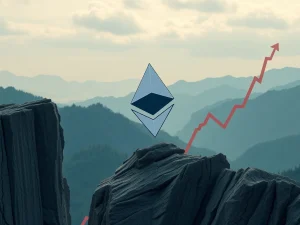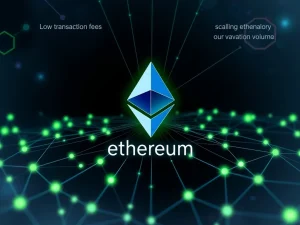Ethereum’s Uncertain Future: Can It Reclaim Its Crypto Crown?

Ethereum, the once undisputed king of smart contracts and decentralized applications, has been facing headwinds. Is the shine wearing off, or is this just a temporary dip before a powerful resurgence? Our latest Crypto News Insights video dives deep into the burning question: Has Ethereum lost its edge? Experts are weighing in, and the future of Ether in 2025 hangs in the balance. Let’s explore the factors behind Ether’s recent performance and uncover the potential for a dramatic comeback.
Ethereum’s Dominance: A Look Back at the Crypto Giant
For years, Ethereum reigned supreme. It wasn’t just another cryptocurrency; it was the platform that birthed the decentralized finance (DeFi) revolution, the NFT craze, and countless innovative blockchain projects. Ethereum’s initial edge came from being the first truly programmable blockchain, enabling developers to build complex applications beyond simple transactions. Think back to the early days of crypto – Ethereum was synonymous with innovation. It pioneered:
- Smart Contracts: Revolutionizing agreements and automation on the blockchain.
- Decentralized Applications (dApps): Creating a new internet paradigm, moving away from centralized control.
- ERC-20 Tokens: Becoming the standard for token creation and ICOs, fueling the initial crypto boom.
- DeFi Ecosystem: Lending, borrowing, and trading platforms built on Ethereum transformed finance.
- NFT Marketplaces: Providing the infrastructure for digital collectibles and art to flourish.
This first-mover advantage solidified Ethereum’s position as the go-to blockchain for developers and investors alike. But the crypto landscape is ever-evolving, and new contenders have emerged, challenging Ethereum’s long-held dominance.
Analyzing Ethereum’s Recent Challenges: Why the Shifting Tides?
While Ethereum remains a powerhouse, it’s undeniable that market analysis indicates a shift in momentum. Several factors have contributed to this perceived loss of edge. Let’s break down some key challenges:
| Challenge | Impact on Ethereum |
|---|---|
| High Gas Fees | Transaction costs on Ethereum can be exorbitant, especially during peak network activity. This makes smaller transactions economically unviable and hinders user adoption for everyday applications. |
| Scalability Issues | Ethereum’s original proof-of-work consensus mechanism limited its transaction processing speed. Network congestion leads to slow transaction times and increased fees. |
| Rising Competition | Newer blockchains like Solana, Avalanche, and Binance Smart Chain have emerged, offering faster transaction speeds and lower fees. These “Ethereum killers” have attracted developers and users seeking alternatives. |
| Delays in Ethereum 2.0 (The Merge) | The highly anticipated upgrade to Ethereum 2.0, promising to address scalability and energy efficiency, faced numerous delays. This created uncertainty and allowed competitors to gain ground. |
| Complexity of Development | While powerful, Ethereum’s development environment can be complex for newcomers compared to some newer, more user-friendly platforms. |
These challenges have collectively raised questions about Ethereum’s long-term viability as the leading blockchain platform. Has the competition become too fierce? Are the technological hurdles too significant?
Experts Weigh In: Has Ethereum Really Lost Its Crown?
To understand the real picture, we need to consider what experts are saying. Opinions are divided, painting a nuanced perspective on Ethereum’s current situation.
- The Pessimistic View: Some analysts argue that Ethereum’s slow progress on scalability and high fees have irrevocably damaged its competitive position. They point to the rapid growth of alternative Layer-1 blockchains and the migration of projects away from Ethereum as evidence of decline. These experts suggest that while Ethereum will remain relevant, it may no longer be the dominant force it once was.
- The Optimistic View: On the other hand, many experts maintain a bullish stance on Ethereum. They emphasize the massive network effects, the robust developer community, and the ongoing development of Ethereum 2.0. They believe that “The Merge,” the transition to proof-of-stake, and subsequent scaling solutions will ultimately resolve Ethereum’s challenges and solidify its position as the leading blockchain for the future. They see the current phase as a necessary evolution, not a decline.
- The Pragmatic View: A more balanced perspective acknowledges both the challenges and the strengths. These experts believe that Ethereum’s future success hinges on the successful and timely implementation of its upgrades. They recognize the competitive landscape but highlight Ethereum’s established ecosystem and brand recognition as significant advantages. They see a future where Ethereum might coexist with other successful blockchains, each catering to different needs and use cases.
The consensus seems to be that Ethereum’s story is far from over. The next few years will be critical in determining whether it can overcome its current hurdles and reclaim its undisputed leadership.
Ethereum 2.0: The Potential Game Changer for Ether’s Future
The key to Ethereum’s potential comeback lies in Ethereum 2.0, now often referred to as simply “Ethereum” post-Merge. This series of upgrades is designed to address the core issues that have hindered Ethereum’s growth. The most significant milestone, “The Merge,” transitioned Ethereum from a proof-of-work (PoW) to a proof-of-stake (PoS) consensus mechanism. This is a monumental shift with profound implications:
- Enhanced Scalability: PoS is a crucial step towards sharding, a future upgrade that will drastically increase Ethereum’s transaction processing capacity.
- Reduced Energy Consumption: Proof-of-stake is significantly more energy-efficient than proof-of-work, addressing environmental concerns and making Ethereum more sustainable.
- Lower Transaction Fees (Potentially): While The Merge itself didn’t directly lower gas fees, it lays the groundwork for future scaling solutions that are expected to reduce transaction costs.
- Increased Security: PoS can potentially enhance network security by making it more costly and difficult for malicious actors to attack the network.
Beyond The Merge, other Ethereum 2.0 upgrades like sharding are in the pipeline, promising further improvements in scalability and efficiency. The successful implementation of these upgrades is crucial for Ethereum to regain its competitive edge and cater to the demands of a growing decentralized ecosystem.
Unlocking Ethereum’s Potential: Pathways to a Resurgence
For Ethereum to not just survive but thrive and reclaim its crypto crown, several key factors need to align. Let’s explore what needs to happen to unlock Ethereum’s potential for a powerful resurgence:
- Successful and Timely ETH 2.0 Upgrades: The continued rollout of Ethereum 2.0 upgrades, particularly sharding, is paramount. These upgrades must be implemented smoothly and efficiently to deliver on their promises of scalability and lower fees.
- Lowering Gas Fees: Finding effective solutions to reduce gas fees remains a critical challenge. Layer-2 scaling solutions like rollups are playing an increasingly important role in mitigating this issue.
- Improving Transaction Speed: Faster transaction processing is essential to compete with newer, faster blockchains. Ethereum needs to demonstrate significant improvements in transaction throughput.
- Ecosystem Growth and Innovation: Maintaining and expanding its vibrant developer ecosystem is crucial. Attracting new and innovative projects to build on Ethereum will solidify its position as a leading platform.
- Community Support and Adoption: Continued strong community support and widespread adoption are vital for Ethereum’s long-term success. This includes both developers and users embracing the platform and its vision.
If Ethereum can successfully navigate these pathways, it has a strong chance of not just regaining its edge but also solidifying its position as a foundational layer of the decentralized web.
Investing in Ether: Is it a Smart Move in 2025?
From a market analysis perspective, investing in Ether in 2025 presents a complex picture. The potential upside is significant if Ethereum successfully executes its roadmap and overcomes its challenges. However, the risks are also considerable given the competitive landscape and the inherent volatility of the crypto market.
Potential Upsides:
- ETH 2.0 Success: If Ethereum 2.0 delivers on its promises, Ether’s value could see substantial appreciation.
- Continued DeFi and NFT Growth: Ethereum remains the dominant platform for DeFi and NFTs. Continued growth in these sectors could drive demand for Ether.
- Institutional Adoption: Increased institutional adoption of cryptocurrencies could benefit established platforms like Ethereum.
Potential Downsides:
- Competitive Pressure: Other blockchains could continue to gain market share, limiting Ethereum’s growth potential.
- Regulatory Uncertainty: Evolving regulations in the crypto space could impact Ethereum and the broader market.
- Technological Risks: Unforeseen technical challenges in the implementation of Ethereum 2.0 could negatively affect Ether’s price.
Disclaimer: This is not financial advice. Investing in cryptocurrencies is highly speculative and involves significant risks. Conduct thorough research and consult with a financial advisor before making any investment decisions.
Conclusion: Ethereum’s Future – A Story of Resilience and Potential
So, has Ethereum lost its edge? The answer is not a simple yes or no. Ethereum has undoubtedly faced challenges and increased competition. However, to declare it down and out would be premature. Ethereum possesses immense strengths – a massive ecosystem, a dedicated community, and groundbreaking technological upgrades on the horizon. The journey ahead may be uncertain, but Ethereum’s history is one of innovation and resilience. As we look towards 2025, the potential for Ethereum to not just recover but to redefine the crypto landscape remains powerfully present. Keep watching Crypto News Insights for ongoing analysis and updates on Ethereum’s fascinating journey.









